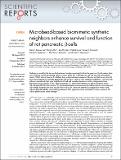Microbead-based biomimetic synthetic neighbors enhance survival and function of rat pancreatic β-cells
Author(s)
Lee, Samuel; Ma, Minglin; Kim, Soo Min; Guye, Patrick; Pancoast, James R.; Weiss, Ron; Lee, Richard T.; Anderson, Daniel Griffith; Hammond, Paula T; Li, W.; ... Show more Show less
DownloadLi-2013-Microbead-based biom.pdf (1.574Mb)
PUBLISHER_CC
Publisher with Creative Commons License
Creative Commons Attribution
Terms of use
Metadata
Show full item recordAbstract
Diabetes is caused by the loss or dysfunction of insulin-secreting β-cells in the pancreas. β-cells reduce their mass and lose insulin-producing ability in vitro, likely due to insufficient cell-cell and cell-extracellular matrix (ECM) interactions as β-cells lose their native microenvironment. Herein, we built an ex-vivo cell microenvironment by culturing primary β-cells in direct contact with ‘synthetic neighbors', cell-sized soft polymer microbeads that were modified with cell-cell signaling factors as well as components from pancreatic-tissue-specific ECMs. This biomimetic 3D microenvironment was able to promote native cell-cell and cell-ECM interactions. We obtained sustained maintenance of β-cell function in vitro enhanced cell viability from the few days usually observed in 2D culture to periods exceeding three weeks, with enhanced β-cell stability and insulin production. Our approach can be extended to create a general 3D culture platform for other cell types.
Date issued
2013-10Department
Harvard University--MIT Division of Health Sciences and Technology; Massachusetts Institute of Technology. Department of Biological Engineering; Massachusetts Institute of Technology. Department of Chemical Engineering; Koch Institute for Integrative Cancer Research at MITJournal
Scientific Reports
Publisher
Nature Publishing Group
Citation
Li, Wei, Samuel Lee, Minglin Ma, Soo Min Kim, Patrick Guye, James R. Pancoast, Daniel G. Anderson, Ron Weiss, Richard T. Lee, and Paula T. Hammond. “Microbead-based biomimetic synthetic neighbors enhance survival and function of rat pancreatic β-cells.” Scientific Reports 3 (October 4, 2013).
Version: Final published version
ISSN
2045-2322